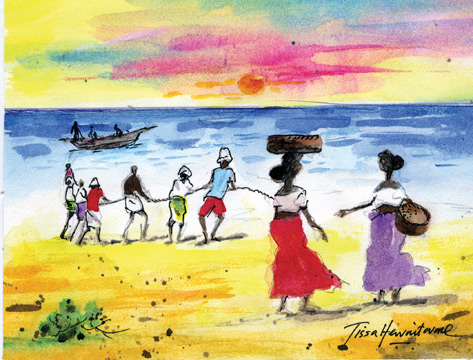Painting the sea beach
by Tissa Hewavitharane
Ever since I loved to paint outdoor scenes my favourite subject was
the sea. The coastline is gifted with long sandy beaches and a rich deep
blue sea near my home Mt.Lavinia. The waters of the ocean hit the rocks
and provide the music. This peaceful area along the coast line is strewn
with restful bays and reefs emerging and submerging with the waves.
Coral islets bask in the sun, and brown-green coconut groves stretch
out into the endless distance where the sky meets the ocean waves. The
morning winds blow gently on the ancient outriggers which meet the
rigours of the sea in the trusting hands of the seasoned fisherman.
The day is transformed in the evening when the fishing boats start
coming home. The boats are heavy with the day's catch of different fish.
The fish-mongers are impatient, vying with each other to dispose of the
catch. They are capable of breathing life into the dead fish to clinch
the deal with the waiting buyers.
Fishing boats
When painting a beach scene with numerous subjects such as fishermen
casting the net, fishing boats back home, fishing with Maha-dela (large
net) and young bellies with colourful cloth and jacket closely fitting
the shapely figure with large baskets waiting to buy their portion of
fish have the effect of intensifying each other.
 This creates a luminous glow that spells out a beautiful, vibrant
beach scene. When composing a evening beach scene, remember that either
the bright, warm areas should dominate, or the cool dark shadow areas.
If there is an even spread of lights and darks the effect of bright
sunshine will be lost. This creates a luminous glow that spells out a beautiful, vibrant
beach scene. When composing a evening beach scene, remember that either
the bright, warm areas should dominate, or the cool dark shadow areas.
If there is an even spread of lights and darks the effect of bright
sunshine will be lost.
Everything the sun hits becomes warmer and more intense in colour,
whereas objects in shadow are correspondingly cool. Shadows are a
marvellous device for conveying an impression of bright sunshine.
The sky at sunset takes on a radiant glow which even the brightest
pigment colours can never hope to match.
The artist, therefore, should know how to use his skill to create the
illusion of radiant light in his painting.
One way to do this is by including warm and cool colours in the sky,
because a warm colour always appears, warmer and brighter when placed
next to a cool colour.
When painting the sunset, use pure clear transparent pigments which
allow light to reflect off the paper and up through the colours, thus
increasing the impression of light and luminosity. Adjacent warm and
cool colours have the effect of intensifying each other, and this
creates a luminous glow that spells the sunset.
Selection of colours in a painting is dictated by the method of
working. Colour can be realistic, adhering to nature as closely as
possible, or it can be subjective, with the artist using colour he feels
is right at that time. Between these two extremes exists a wide range of
possibilities, depending on the purpose of the artist.
Interest
Most amateurs fail in painting beach scenes because of poor
composition. Always compose your scenes with a simple foreground which
make it easy for the viewer to enter your picture and be led to the
centre of interest. Do not clutter your beaches with too much details.
Keep them very simple and but on the paint with authority and leave
them fresh transparent. A few simple figures on a beach give life and
scale but be careful where you place them and keep your strokes to a
minimum, with no details.
In the painting I have done here, there are no details on the
figures. Notice the fisherman at a distance pulling the net and how the
dark tones accentuate the brightness of the sky in the painting. The two
women talking to each other bring life to the painting by aiming to
capture the gesture and shape.
Technique
It is difficult to use the technique of painting on a wet background
or just the technique of painting on a dry back ground in any given
painting. Usually they are used simultaneously to achieve the desired
effect of each. The wet background allows effects of the atmosphere,
vague shades merging areas, gradations and the merging and blending of
colour.
The wetness is controlled with absorbent paper, with a sponge or dry
brush or by the natural evaporation of the water. The drying time for
each coat of paint vans wait. Therefore, for the paper to dry a little.
If you paint while the paper is still wet the colour will run and blend
completely while the back is still wet, but not soaked, a darker colour
could be added.
With a dryer base, the form of the brush stroke can be controlled
much better. Controlling the flow of the paint on the paper improves as
the paper dries. It is important to remember that you cannot paint light
tones over dark tones with watercolour paints. It must always be the
other way around. |

